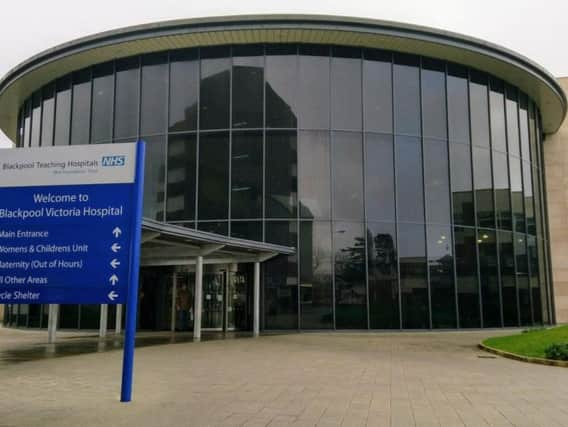Blackpool hospital worst in country at treating patients within four hours


The Vic managed to see just 40.1 per cent of patients turning up at A&E within four hours in December compared to the national average of 77.3 per cent. No other trust was below 57 per cent.
More than one in seven of all patients forced to wait more than 12 hours in A&E across England last month were in Blackpool. Only Bristol left more people waiting for half a day than the resort’s 75.
Advertisement
Hide AdAdvertisement
Hide AdLast December the Vic saw 61 per cent of A&E patients within the target, a better result even though the total number of people turning up was 6,902 compared to this year’s 6,028. The total number of patients seen in December, including walk-in centres – was up by 983 to 17,078 last month.
Meanwhile trusts up and down the country are seeing no let up in pressure in the new year, with some fearing the worst is yet to come.
A spokesman for the Vic said the severity of cases seen last month meant people were spending longer on the ward, while the success of efforts to get patients with more minor conditions to seek treatment elsewhere – such as walk-in centres – meant a greater proportion of those seen at the hospital needed more intensive treatment, causing delays for other patients.
The Gazette also reported yesterday how so-called bed-blocking – when patients are well enough to leave and want to do so but cannot due to a lack of social care provision – is adding to the strain on hospital wards.
Advertisement
Hide AdAdvertisement
Hide AdThe spokesman added: “The health system across the Fylde was under severe and sustained pressure over the Christmas period and this challenging situation continued into the New Year.
“During this time pressures on our services led to an unusually large number of A and E breaches.
“Our primary concern during this period was the safety of patients and the compassion and commitment of staff ensured that the level of patient care remained high through these challenging times.
“However, we are of course sorry for any extended waiting times experienced by patients and their families during this exceptionally busy period.”
Advertisement
Hide AdAdvertisement
Hide AdHe added that because fewer patients with more minor conditions were coming to A&E it meant those in the emergency department had more complex needs and required ‘more care and attention from our senior clinical teams prior to admission to ensure they get the best possible care’.
“The situation has improved over the last week and we would like to thank our fantastic staff for their on-going efforts during this extremely challenging period and the public for their understanding and co-operation,” he added.
“Extra medical and nursing staff were employed in all key areas and extra bed space was opened at Blackpool Victoria Hospital.”
Nationally the picture is of an ongoing crisis as the figures show waiting time targets in accident and emergency departments have hit their lowest level in 14 years, with patients ‘dying prematurely’ in their corridors before they are seen, according to some consultants.
Advertisement
Hide AdAdvertisement
Hide AdStaff have been faced with rising numbers of flu cases and respiratory illness, with 48 flu-related deaths in England so far this winter.
More than 60 A&E department heads in England and Wales have written to Prime Minister Theresa May to warn that the ‘current level of safety compromise is at times intolerable’, as the winter months put the NHS under further strain.
The consultants’ letter, leaked to the Health Service Journal, acknowledged the best efforts of staff, trusts and clinical commissioning groups.
But it adds: “The facts remain, however, that the NHS is severely and chronically underfunded. Thousands of patients are waiting in ambulances for hours as the hospitals lack adequate space,” they wrote.
Advertisement
Hide AdAdvertisement
Hide Ad“Some of our own personal experiences range from over 120 patients a day managed in corridors, some dying prematurely.”
Answering questions after a speech in south London on Thursday, Mrs May said flu was putting extra pressure on services.
“As we know, every year and winter the National Health Service comes under additional pressure, and we’ve seen the extra pressures that the NHS has come under this year,” she said.
“We have seen in recent days an increase in the number of people presenting at Accident and Emergency from flu. The NHS today has launched their national flu programme and I would encourage people to act on the advice that the NHS is giving and also encourage NHS staff who haven’t had the flu vaccine yet to have that vaccine.”
Advertisement
Hide AdAdvertisement
Hide AdThe Royal College of Surgeons said it was ‘disappointing’ that just 77.3 per cent of patients at major A&E departments were treated within four hours, worse than in December 2016 when 79.3 per cent of patients were seen.
A spokesman added: “It further demonstrates why it has been necessary to cancel patients’ non-urgent procedures until the end of January. ’Despite the best efforts and dedication of NHS staff to treat patients quickly, waiting times for non-urgent care have also deteriorated again in the past year.”
The figures show that bed occupancy levels have gone back up to 95%, but, more positively, delayed transfers of care - when a patient is ready to leave a hospital - were lower than at the same point in any of the past four years.